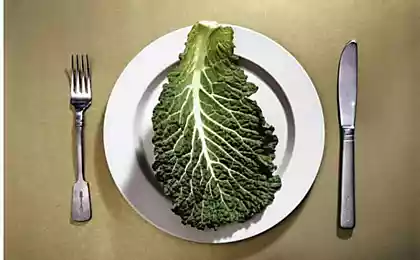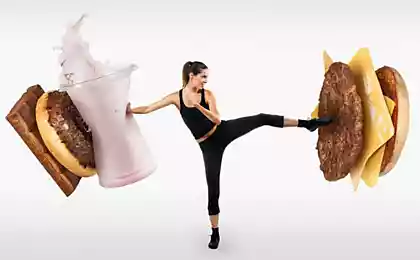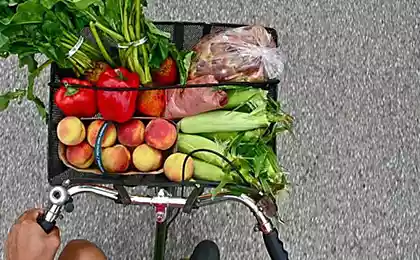779
The demand for products in various types of food
It is known that natural food, namely, raw food diet provides the body with nutrients the most efficiently. The question of how great the need naturist-rawfoodist in food compared to a traditional mixed diet, studied doctor of biological Sciences P. Kiskin. This article, which is presented here with minor cuts, was published in the journal "Agriculture in Moldova", 1987, N 11.
It has long been known properties of plants, the use of which is customary now to call the herbal medicine. The Arsenal of traditional medicine has more than 600 such plants, which is three times more than the number of medicinal plants attracted official pharmacology.
However, plants possess preventive and curative properties. Among them are widely cultivated and available vegetables, fruits, cereals, oilseeds, as everywhere common wild plants.

Hippocrates, the father of medicine, 24 centuries ago believed that human medicine should serve primarily plants, used as food. Now nutritionists widely recommend a plant-based diet to prevent, especially gastrointestinal, cardiovascular, metabolic diseases.
Adopted in our country regulations on the protection of the environment and rational use of natural resources, the fight against drunkenness and alcoholism and measures against drug and substance abuse encourage people to lead a more healthy lifestyle, to involve for these purposes, the healing factors of environmental aspect, including useful plants.
Here we shall mention only the role of food plants in human health, in terms of its needs, health and the environment.
In the world annually developed hundreds of different diets. They can be divided depending on the used products and technologies of cooking into three types:
1) mixed, including products of plant and animal origin
2) vegetarian, consisting of grain crops, or with the addition of "neubulach products (milk, eggs, caviar, etc.), often with technological processing,
3) fresh, raw cultural or wild plants, where short-term treatment of fire have only to cereals and legumes.
All these groups supply a number of inherent advantages and nedostatkiV. But the last two differ in that they no longer meet the current needs of people leading a sedentary lifestyle in the cities and industrial centers of the country, primarily due to the low energy intake of their diets, preventing obesity, and overweight.
According to the nutrition Institute of the country, the generally accepted average daily requirement of food people of intellectual labor, figured on 3000 Kcal., provides about 2.2 kg of food per day.
In a mixed diet this diet includes:
With reduced now calorie food to 2500 Calories. — the total amount, not including fluids, increased slightly due to the addition in the diet of vegetables and fruits. Norms flour products decreased markedly.
For the average daily intake of foods consumed in natural nutrition, you need to:
Such a diet, although is provided approximately 1 kilogram of product or 1650 — 1800 Kcal. (with a mixed diet such calorie recommended for children 2 to 3 years! A. Mazurin, 1987), we believe, has a healing effect.
In the average diet, the total estimated requirements for products per person per year, according to J. A. Orlova (1986) are:
When natural food (by our calculations), respectively: 124, 62, and 15 kg, i.e. to a much lesser extent (see table).
The consumption of fruit the same, and vegetables with more natural diet.

The demand for products in various types of food
Product
grams per day
kg natural
mixed
natural
mixed
Vegetables, melons 400 250 124 164 Potatoes 30 300 11 110 Fruits, berries 200 200 62 72 30 15 12 Dried fruit 6 cereal 100 450 15 100 or 115 kg of bread Seeds oilseeds 75 — 13,5 — Greens, herbs 100 — 24 — Nuts 50 — 12 — Med 20 — 4 — Pollen 5 — 0,25 — Wild herbs for teas 10 — 2 — Spices, condiments 10 20 3,1 6 (not including pickles) Vegetable oil 15 20 5 8 meat, Meat products — 200 — 78 Milk, milk. products — 400 — 405 Butter — 50 — 18 Curd — 30 — 12 sour Cream — 15 — 6 Cheese — 20 — 8 Egg — 1 piece — 360 pieces of Sugar, including sweets — 100 — 36 Macaroni — 10 — 3,6 Cereal grains and legumes — 30 — 12 Potato starch — 10 — 3,3 Wheat flour — 25 — 10 salt — 10 — 4 (no pickles) Only:
In Kcal.
1045 g 2155 g 276 kg
1173 kg
1650 — 1800 2500 — 3000 published
Author: P. KESKIN, doctor of biological Sciences
P. S. And remember, only by changing their consumption — together we change the world! ©
Join us in Facebook , Vkontakte, Odnoklassniki
Source: www.syroedenie.com/articles/kiskin.html
It has long been known properties of plants, the use of which is customary now to call the herbal medicine. The Arsenal of traditional medicine has more than 600 such plants, which is three times more than the number of medicinal plants attracted official pharmacology.
However, plants possess preventive and curative properties. Among them are widely cultivated and available vegetables, fruits, cereals, oilseeds, as everywhere common wild plants.

Hippocrates, the father of medicine, 24 centuries ago believed that human medicine should serve primarily plants, used as food. Now nutritionists widely recommend a plant-based diet to prevent, especially gastrointestinal, cardiovascular, metabolic diseases.
Adopted in our country regulations on the protection of the environment and rational use of natural resources, the fight against drunkenness and alcoholism and measures against drug and substance abuse encourage people to lead a more healthy lifestyle, to involve for these purposes, the healing factors of environmental aspect, including useful plants.
Here we shall mention only the role of food plants in human health, in terms of its needs, health and the environment.
In the world annually developed hundreds of different diets. They can be divided depending on the used products and technologies of cooking into three types:
1) mixed, including products of plant and animal origin
2) vegetarian, consisting of grain crops, or with the addition of "neubulach products (milk, eggs, caviar, etc.), often with technological processing,
3) fresh, raw cultural or wild plants, where short-term treatment of fire have only to cereals and legumes.
All these groups supply a number of inherent advantages and nedostatkiV. But the last two differ in that they no longer meet the current needs of people leading a sedentary lifestyle in the cities and industrial centers of the country, primarily due to the low energy intake of their diets, preventing obesity, and overweight.
According to the nutrition Institute of the country, the generally accepted average daily requirement of food people of intellectual labor, figured on 3000 Kcal., provides about 2.2 kg of food per day.
In a mixed diet this diet includes:
- 400 grams of bread,
- 300 potatoes
- 200 meat and meat products,
- 400 milk and dairy products,
- 50 of butter,
- 30 cheese,
- 15 sour cream,
- 40 cheese
- 100 grams of sugar, including sweets,
- one egg,
- 250 grams of vegetables,
- 200 fruits and berries etc. (see table).
With reduced now calorie food to 2500 Calories. — the total amount, not including fluids, increased slightly due to the addition in the diet of vegetables and fruits. Norms flour products decreased markedly.
For the average daily intake of foods consumed in natural nutrition, you need to:
- 400 grams of vegetables
- 200 fruit
- 100 grams of cereals,
- 75 — oilseeds,
- 50 — nuts
- 20 grams of honey and some other products.
Such a diet, although is provided approximately 1 kilogram of product or 1650 — 1800 Kcal. (with a mixed diet such calorie recommended for children 2 to 3 years! A. Mazurin, 1987), we believe, has a healing effect.
In the average diet, the total estimated requirements for products per person per year, according to J. A. Orlova (1986) are:
- 164 pounds of vegetables and melons (excluding 110 kg of potatoes),
- 72 fruit
- 100 grains or 115 pounds of bread.
When natural food (by our calculations), respectively: 124, 62, and 15 kg, i.e. to a much lesser extent (see table).
The consumption of fruit the same, and vegetables with more natural diet.

The demand for products in various types of food
Product
grams per day
kg natural
mixed
natural
mixed
Vegetables, melons 400 250 124 164 Potatoes 30 300 11 110 Fruits, berries 200 200 62 72 30 15 12 Dried fruit 6 cereal 100 450 15 100 or 115 kg of bread Seeds oilseeds 75 — 13,5 — Greens, herbs 100 — 24 — Nuts 50 — 12 — Med 20 — 4 — Pollen 5 — 0,25 — Wild herbs for teas 10 — 2 — Spices, condiments 10 20 3,1 6 (not including pickles) Vegetable oil 15 20 5 8 meat, Meat products — 200 — 78 Milk, milk. products — 400 — 405 Butter — 50 — 18 Curd — 30 — 12 sour Cream — 15 — 6 Cheese — 20 — 8 Egg — 1 piece — 360 pieces of Sugar, including sweets — 100 — 36 Macaroni — 10 — 3,6 Cereal grains and legumes — 30 — 12 Potato starch — 10 — 3,3 Wheat flour — 25 — 10 salt — 10 — 4 (no pickles) Only:
In Kcal.
1045 g 2155 g 276 kg
1173 kg
1650 — 1800 2500 — 3000 published
Author: P. KESKIN, doctor of biological Sciences
P. S. And remember, only by changing their consumption — together we change the world! ©
Join us in Facebook , Vkontakte, Odnoklassniki
Source: www.syroedenie.com/articles/kiskin.html























